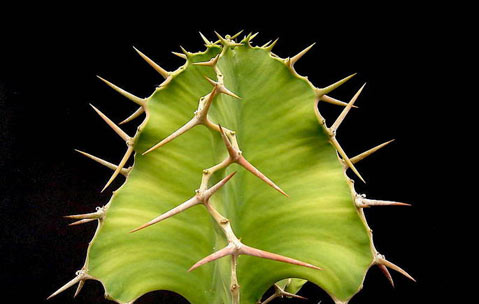Armored Flora
Plants Poke, Taste Bad, and Even Poison Their Predators

The myriad ways that plants have evolved to adapt to their environments are sometimes stunning and even mysterious. Bright flowers attract pollinators, succulent leaves ward off desiccation, bark protects growth cells; the list is nearly endless. So what’s with those plants that sport spines and prickles and thorns? Also adaptive.
Most such pokey bits are there to protect the plant from predation by some sort of large herbivore. Or so botanists think. The common belief is that spines on cacti help protect the water-storage trunk of the plant from being eaten in the extreme heat and dryness of the deserts where they grow. Not only did cacti evolve to protect their bodies with armament; they did it by sacrificing their leaves! Those spines, according to the plant anatomist, are formed from the same source of tissue that in an oak tree results in leaves. There are consequences for this trade-off, of course, but these strange and wonderful creatures were able to sequester their photosynthetic systems in their stems and never look back.
On the other side of the world (cactuses are mostly American in origin), there are spiny succulent plants in Africa, Arabia, and India, as well. Many of these are in the euphorbia family, and they have gone another direction entirely. Leaves may still make a brief appearance in their life cycle—when conditions are very favorable. Their thorns, however, are direct outgrowths of their epidermis, or skin-like covering. Agaves and aloes, also very distinct plant groups that arose after the breakup of Pangaea that separated the Americas from most of the rest of the world, both store moisture within their oversized and stiff leaves and line them with more or less fierce thorns. Interestingly, aloes and euphorbias also employ some irritating, perhaps even deadly, chemicals in their defense. The milky sap of succulent euphorbias is bitter and can actually result in dermatitis or gastrointestinal distress if ingested. While the sap of many aloes may be bitter—a possible deterrent to the casual herbivore—it also has some medicinal applications. Plant chemistry is endlessly interesting.
Other plants are thorny. Take the rose. Perhaps this adaptation was to deter some predators, but anyone who gardens where deer cohabit—or at least live nearby—will attest that roses are among their favorite foods. The thorns that are such a trial to humans trying to keep them pruned and groomed seem to have no deterrent quality at all for deer. Many acacia species in Africa are also well armed with thorns of varying sizes, but that doesn’t stop the giraffes from wrapping their long (amazingly so) and flexible tongues around the stems and chewing them down with seemingly no injury.
Unlike animals, which can run, hide, and even actively fight back, plants are rooted in the ground. They sprout, grow, and die in the same place, so they have found ways to defend themselves that are more passive, but usually quite effective. Plants poke, taste bad, and even poison their predators. And they don’t just do it to animals; they do it to each other. But that’s another story.



